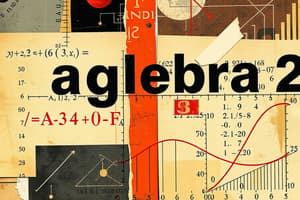Podcast
Questions and Answers
What is the mean?
What is the mean?
- Max - Min
- Add up all numbers and divide by the number of numbers (correct)
- Middle number
- Number that occurs most often
What is the median?
What is the median?
Middle number
What is the mode?
What is the mode?
Number that occurs most often
What is the range?
What is the range?
What is variance?
What is variance?
What is standard deviation?
What is standard deviation?
How do you sort a list on a calculator?
How do you sort a list on a calculator?
How do you enter data on a calculator?
How do you enter data on a calculator?
What is the definition of a box and whisker plot?
What is the definition of a box and whisker plot?
What is the interquartile range?
What is the interquartile range?
What does the union in Venn diagrams represent?
What does the union in Venn diagrams represent?
What does the intersection in Venn diagrams represent?
What does the intersection in Venn diagrams represent?
What is a frequency table?
What is a frequency table?
What is the Average Mean?
What is the Average Mean?
What is a skewed histogram?
What is a skewed histogram?
What is the sample space in probability?
What is the sample space in probability?
How is probability defined?
How is probability defined?
What does mutually exclusive mean?
What does mutually exclusive mean?
What defines independent events?
What defines independent events?
What are complements in probability?
What are complements in probability?
What is conditional probability?
What is conditional probability?
What percentage of data falls within one standard deviation from the mean in a normal distribution?
What percentage of data falls within one standard deviation from the mean in a normal distribution?
What is the domain for exponential functions?
What is the domain for exponential functions?
What is the range for exponential functions?
What is the range for exponential functions?
What is the y-intercept for exponential functions?
What is the y-intercept for exponential functions?
What is the horizontal asymptote for exponential functions?
What is the horizontal asymptote for exponential functions?
What is 'e' in mathematics?
What is 'e' in mathematics?
How do you turn on the correlation coefficient on a calculator?
How do you turn on the correlation coefficient on a calculator?
How do you find the correlation coefficient?
How do you find the correlation coefficient?
What is the log to exponential conversion?
What is the log to exponential conversion?
What are log properties 1-4?
What are log properties 1-4?
What are log properties 5-7?
What are log properties 5-7?
What is the change of base formula?
What is the change of base formula?
What is the domain of log graphs?
What is the domain of log graphs?
What is the range of log graphs?
What is the range of log graphs?
What is the x-intercept of logs?
What is the x-intercept of logs?
What is the vertical asymptote of logs?
What is the vertical asymptote of logs?
What is the half-life formula?
What is the half-life formula?
What is the rule when solving logs?
What is the rule when solving logs?
How do you simplify rational expressions?
How do you simplify rational expressions?
What are excluded values?
What are excluded values?
What is the sum of cubes?
What is the sum of cubes?
What is the difference of cubes?
What is the difference of cubes?
How do you divide rational expressions?
How do you divide rational expressions?
How do you add and subtract rational expressions?
How do you add and subtract rational expressions?
What is a complex fraction?
What is a complex fraction?
What is the domain of rational fractions?
What is the domain of rational fractions?
What are the vertical asymptotes of rational fractions?
What are the vertical asymptotes of rational fractions?
What are the zeroes of rational fractions?
What are the zeroes of rational fractions?
What are the horizontal asymptotes of rational fractions?
What are the horizontal asymptotes of rational fractions?
What are the holes of rational fractions?
What are the holes of rational fractions?
What is completing the square?
What is completing the square?
What are the key parts of a parabola?
What are the key parts of a parabola?
What are the key parts of a circle?
What are the key parts of a circle?
How do you find the point of intersection of two circles?
How do you find the point of intersection of two circles?
What is a tangent?
What is a tangent?
What are the key parts of an ellipse?
What are the key parts of an ellipse?
What is the relationship among A, B, and C for an ellipse?
What is the relationship among A, B, and C for an ellipse?
What are the key parts of a hyperbola?
What are the key parts of a hyperbola?
What are the asymptotes of a hyperbola?
What are the asymptotes of a hyperbola?
How to identify the features of a parabola?
How to identify the features of a parabola?
How to identify the features of a circle?
How to identify the features of a circle?
How to identify the features of an ellipse?
How to identify the features of an ellipse?
How to identify the features of a hyperbola?
How to identify the features of a hyperbola?
What is a degenerate parabola?
What is a degenerate parabola?
What is a degenerate ellipse/circle?
What is a degenerate ellipse/circle?
What is a degenerate hyperbola?
What is a degenerate hyperbola?
When is a conic degenerate?
When is a conic degenerate?
What is sequence notation?
What is sequence notation?
What is factorial notation?
What is factorial notation?
What is sigma notation?
What is sigma notation?
What is the arithmetic sum?
What is the arithmetic sum?
What is a common ratio?
What is a common ratio?
What is geometric notation?
What is geometric notation?
What is finite sum?
What is finite sum?
What is infinite sum?
What is infinite sum?
What is geometric recursive?
What is geometric recursive?
What is arithmetic recursive?
What is arithmetic recursive?
How do you find the number of terms?
How do you find the number of terms?
How do you write a repeating decimal as a fraction?
How do you write a repeating decimal as a fraction?
Flashcards are hidden until you start studying
Study Notes
Measures of Central Tendency
- Mean: Average of a set of numbers; calculated by adding all values and dividing by the count of values.
- Median: The middle value in a sorted list of numbers.
- Mode: The value that appears most frequently in a data set.
- Range: The difference between the maximum and minimum values in a data set.
Statistical Terms
- Variance: A measure of the dispersion of a set of data points.
- Standard Deviation: Indicates the amount of variation or dispersion in a set of values.
Calculator Functions
- Sort List: Use the commands
stat,sort A(,2nd,oneto organize a list. - Entering Data: Access data entry with
statand thenedit.
Data Representation
- Box and Whisker Plot: Visual representation of data dispersion using quartiles.
- Interquartile Range: Difference between the median of the upper quartile and the lower quartile.
Set Theory
- Union in Venn Diagrams: Represents all elements in sets A or B; denoted as ( A \cup B ).
- Intersection in Venn Diagrams: Represents all elements common to both sets A and B.
Data Visualization
- Stem and Leaf Plots: A method of displaying quantitative data that retains the original data values.
- Frequency Table: A table that displays the number of occurrences of each value in a data set.
Probability Concepts
- Sample Space: All possible outcomes for a random experiment.
- Probability: Calculated as the number of favorable outcomes over the total number of outcomes.
- Mutually Exclusive Events: Events that cannot happen simultaneously; ( P(A \cup B) = P(A) + P(B) ).
- Independent Events: Events where the outcome of one does not affect the other; ( P(A \cap B) = P(A) \times P(B) ).
- Complements: Finding probability of events not happening; calculated as ( 1 - P(\text{event}) ).
Distribution
- Normal Distribution Curve Percentages: 68% of data falls within one standard deviation, 95% within two, and 99.7% within three.
Exponential Functions
- Domain: The set of all real numbers, ( (-\infty, \infty) ).
- Range: All positive real numbers, ( (0, \infty) ).
- Y-Intercept: Always at ( (0, 1) ).
- Horizontal Asymptote: The horizontal line where ( y = 0 ).
Logarithms
- Conversion: Logs can be expressed as exponentials; ( \text{Base}^y = x ) translates to ( \log_{\text{Base}}(x) = y ).
- Properties of Logs: Various properties include addition, subtraction, and transformations involving multiplication or division.
- Domain of Logarithmic Functions: Defined for positive real numbers ( (0, \infty) ).
- Vertical Asymptote: Occurs at ( x = 0 ).
Rational Expressions
- Simplification: Involves canceling common factors from numerators and denominators.
- Excluded Values: Values that make the denominator zero are not included in the domain.
- Horizontal Asymptotes: Determined by comparing leading coefficients of the polynomial.
Conic Sections
- Parabola: Key parts include vertex, focus, and axis of symmetry.
- Circle: Defined by its center and radius.
- Ellipse: Characterized by center, vertices, and foci; relationship between axes is described by ( a^2 - b^2 = c^2 ).
- Hyperbola: Key features include center, vertices, and asymptotes.
Sequences and Series
- Factorial Notation: Expressed as ( n! = n(n-1)(n-2)(\ldots) ).
- Arithmetic and Geometric Sequences: Defined by a common difference or ratio; recursive and explicit formulas can represent both.
Additional Concepts
- Degenerate Conics: When conic sections reduce to simpler forms such as points or lines.
- Finding Terms in Sequences: Plugging known values into formulas to find unknowns.
General Tips
- When solving logarithmic equations, always check for extraneous solutions.
Studying That Suits You
Use AI to generate personalized quizzes and flashcards to suit your learning preferences.




